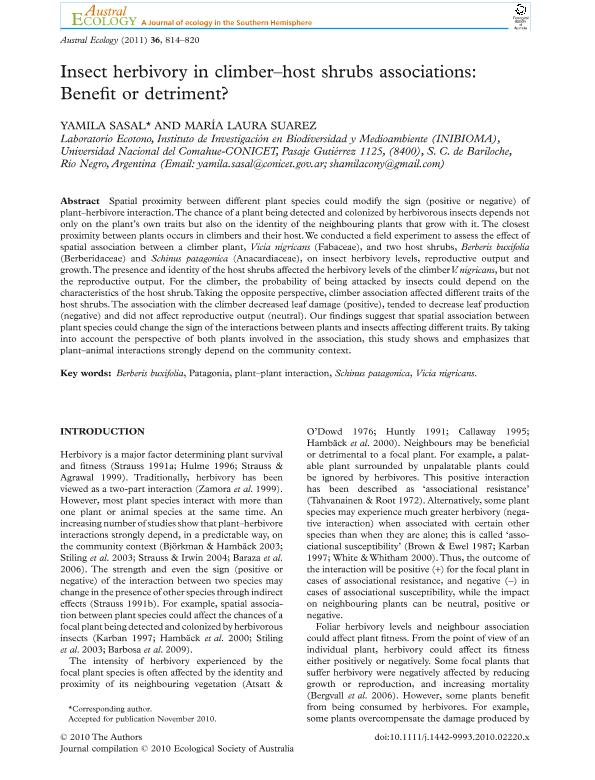Artículo
Insect herbivory in climber-host shrubs associations: Benefit or detriment?
Fecha de publicación:
11/2011
Editorial:
Wiley Blackwell Publishing, Inc
Revista:
Austral Ecology
ISSN:
1442-9985
Idioma:
Inglés
Tipo de recurso:
Artículo publicado
Clasificación temática:
Resumen
Spatial proximity between different plant species could modify the sign (positive or negative) of plant-herbivore interaction. The chance of a plant being detected and colonized by herbivorous insects depends not only on the plant's own traits but also on the identity of the neighbouring plants that grow with it. The closest proximity between plants occurs in climbers and their host. We conducted a field experiment to assess the effect of spatial association between a climber plant, Vicia nigricans (Fabaceae), and two host shrubs, Berberis buxifolia (Berberidaceae) and Schinus patagonica (Anacardiaceae), on insect herbivory levels, reproductive output and growth. The presence and identity of the host shrubs affected the herbivory levels of the climber V. nigricans, but not the reproductive output. For the climber, the probability of being attacked by insects could depend on the characteristics of the host shrub. Taking the opposite perspective, climber association affected different traits of the host shrubs. The association with the climber decreased leaf damage (positive), tended to decrease leaf production (negative) and did not affect reproductive output (neutral). Our findings suggest that spatial association between plant species could change the sign of the interactions between plants and insects affecting different traits. By taking into account the perspective of both plants involved in the association, this study shows and emphasizes that plant-animal interactions strongly depend on the community context.
Archivos asociados
Licencia
Identificadores
Colecciones
Articulos(INIBIOMA)
Articulos de INST. DE INVEST.EN BIODIVERSIDAD Y MEDIOAMBIENTE
Articulos de INST. DE INVEST.EN BIODIVERSIDAD Y MEDIOAMBIENTE
Citación
Sasal, Yamila; Suarez, Maria Laura; Insect herbivory in climber-host shrubs associations: Benefit or detriment?; Wiley Blackwell Publishing, Inc; Austral Ecology; 36; 7; 11-2011; 814-820
Compartir
Altmétricas




